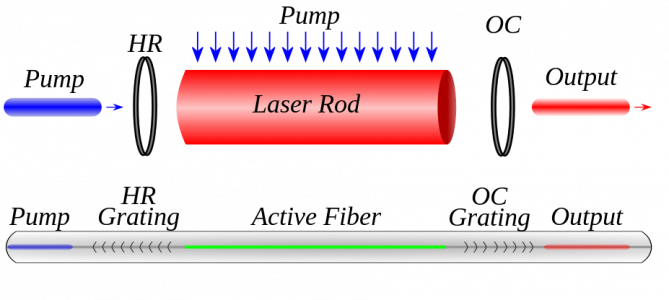Laser School: Part 1 – The most common laser types in industry
Home »
What is a laser? How does it work? The use of lasers in manufacturing has increased steadily over the last 30 years and is expected to increase further in the future. Modern lasers have become incredibly powerful, while the price per kilowatt has gone down, which paves the way for new applications. This is the first of eight sections in our laser school. We’ll look at everything you need to know about laser technology in manufacturing. We hope you enjoy our series of articles!
LASER – Light Amplification by Stimulated Emission of Radiation
The word LASER is an acronym for Light Amplification by Stimulated Emission of Radiation. As early as 1917, Albert Einstein described the basics of the laser based on his theories of the emission of electromagnetic radiation. However, it was Theodore Maiman who designed the first usable laser in 1960.Although the first laser source was produced in the 1960s, it would take another 20 years before the technology was refined and more applications for industrial lasers were identified. In the mid-1980s, the use of industrial lasers picked up pace and its use in industry has since exploded.
CO2 lasers, Nd:YAG lasers, fibre lasers, disk lasers, and diode lasers
The most common types of lasers used in industry are CO2 lasers, Nd:YAG lasers, fibre lasers, disk lasers, and diode lasers.
In CO2 lasers, which are the oldest type of industrial lasers, the laser beam is generated in a gas. This method can be used for laser welding and cutting, for example. Nd:YAG lasers consist of an Nd:YAG-doped crystal, where the laser beam is generated by lamp pumping. This technology is relatively inefficient and largely fell out of favour when fibre lasers and disk lasers essentially revolutionised the world of lasers. In fibre lasers, the emission of light takes place in a fibre to produce a laser beam. The laser medium in fibre lasers is shaped like a tube, unlike disk lasers, where the laser is shaped like a disk. Fibre lasers and disk lasers heralded the introduction of completely new technology that was more efficient, more affordable, and longer lasting. Both fibre lasers and disk lasers can be conducted by way of fibres to produce a high beam quality that is well suited to laser cutting and welding, for example.
A number of years later, diode lasers arrived, which can also be conducted through a fibre. It is also highly efficient but has a slightly more “scattered” laser beam, which is therefore best suited to welding and hardening.
Bright future for laser processing applications
The future of lasers in manufacturing looks bright. Thanks to increased competition and greater efficiency, prices per unit of power have fallen, which means we will see more laser-processed products in the future.
A challenge facing lasers is that many perceive the technology to be complex and inaccessible. Laser technology is new in many industries. Often, new and unknown things are perceived as complicated when they replace things that are familiar and well-known within a company. When laser cutting hit the market in the 1990s, it was perceived as something exotic. It is now the most common technology for cutting sheet metal. We can see clear signs that laser welding is heading in the same direction.
There’s a lot to gain from using lasers in manufacturing, and the fact is that laser technology is simpler than most people think!
At PermanovaPermanova, we want to make it possible for manufacturing companies to take the next step and adopt laser technology. We’re involved throughout the process, even after the installation is complete, so that you get the most out of your laser installation. Visit our website for more information and keep an eye out for “Laser School: Part 2”, where we’ll look at the difference between various laser beams.
skapa dev | 2020-01-09

